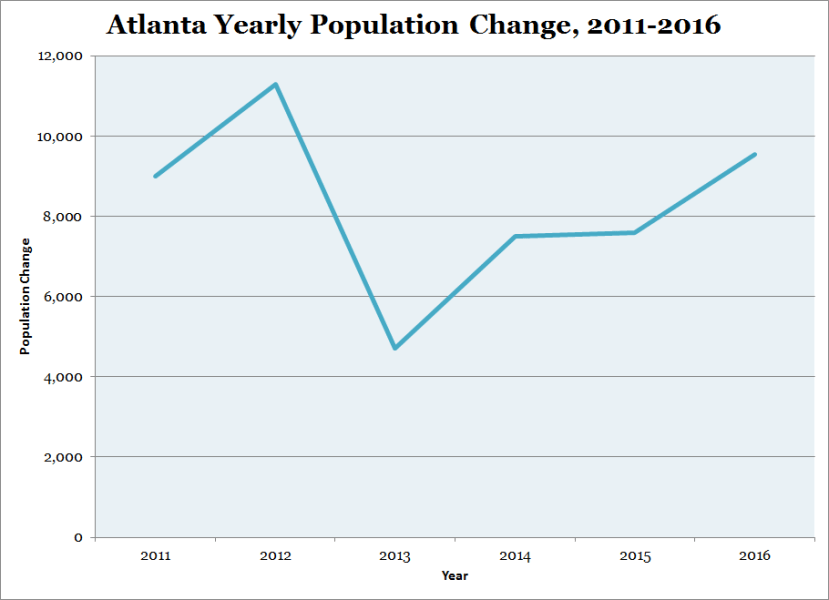The cranes and shimmering glass looming over weary commuters along the downtown connector are more than enough proof that people are flocking to Atlanta. Recently released U.S. Census Bureau numbers provide the empirical data needed to support that conclusion. Between 2015 and 2016, the City of Atlanta added nearly 10,000 new residents, continuing its trajectory towards a new population milestone. In just six years, Atlanta has added half of the 100,000 people it lost during the white flight years of the 1950’s to 1980’s.
In previous decades the growth of a metro area’s principle city often lagged behind that of outlying suburbs. Today, many of these cities are matching or outpacing the growth of their suburban neighbors. As the chart below shows, among the major Atlanta metro area cities, only the Cities of Alpharetta and Gainesville experienced higher population growth rates between 2015 and 2016 than the City of Atlanta.

In the chart above, the red line represents the population growth rate and the blue bars represent the raw change in population numbers. For example, Alpharetta added about 2,000 people, which resulted in a growth rate of about 3%.
The next chart shows the total population of each major Atlanta metro area city in 2016. Little has changed from 2015 with Atlanta, Sandy Springs, and Roswell being the three most populous cities in the metro area.

Much has been made of the growth rates of major American cities over the past 5-10 years. As suburbs lagged in population growth during the Great Recession, many city centers experienced growth rates not seen in 50+ years. As the economy has continued to improve, many have questioned whether cheaper suburban land would hinder urban growth in favor of suburban growth. Both empirical and anecdotal data indicate this is not occurring; while suburban growth is increasing, urban growth remains strong. As the chart below shows, Atlanta’s addition of nearly 10,000 new residents in 2016 is the most since 2012.

It’s important to keep these numbers in perspective. As we’ve previously written, most major American cities experienced massive population losses between the late 1950’s and 1980’s. Atlanta lost 100,000 people between 1960 and 1990. When it did begin to rebound, the growth was tepid at best. Between 1990 and 2010, Atlanta added just 25,000 people.
In 2010, cities began to experience torrential growth rates. Atlanta added 40,000 people between 2010 and 2015. Between 2015 and 2016 it added 10,000 people. In just six years the city has added half of the people it lost during the latter half of the 20th Century.
The next chart is a quick comparison to other major US Cities. We included the two largest US Cities, New York and Los Angeles, as well as other notable cities. While Atlanta added the fewest number of new residents between 2015 and 2016, only Seattle had a higher growth rate.

The chart below shows the population growth rate for the same US Cities between 2010 and 2016.

To round out our 2016 population update, we’ll take a look at the numbers for Atlanta metro area counties. While the 10-region metro area does not officially include Forsyth County, we included it because Forsyth County is not only the same distance from downtown Atlanta as Cherokee County, which is officially included, it is also experiencing the most growth in the metro area.
The chart below shows Fulton County retaining its lead in the share of population among the metro area counties with 21 percent, though Gwinnett isn’t far behind.

The chart below shows Forsyth County’s large lead in population growth between 2015 and 2016. While it only added about 9,000 new residents compared to Fulton’s nearly 16,000, Forsyth County grew by over 4 percent. As with all growth data, it’s important to remember that it is much easier to have a large growth rate when the initial population is small.

For a greater historical context of the numbers please check out our previous articles Ten Ways to Look At Metro Atlanta’s Population Growth and Major US Cities Threaten to Erase Their Population Deficits of the 1950’s-1980’s. The former article includes a breakdown of each Atlanta metro city and county’s share of the entire metro area’s population and comparison between 2015 and 1990 population numbers.
All data courtesy of the U.S. Census Bureau.










